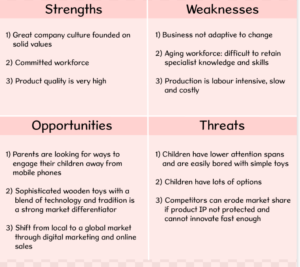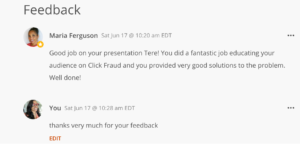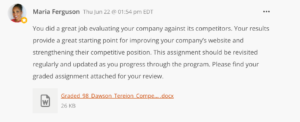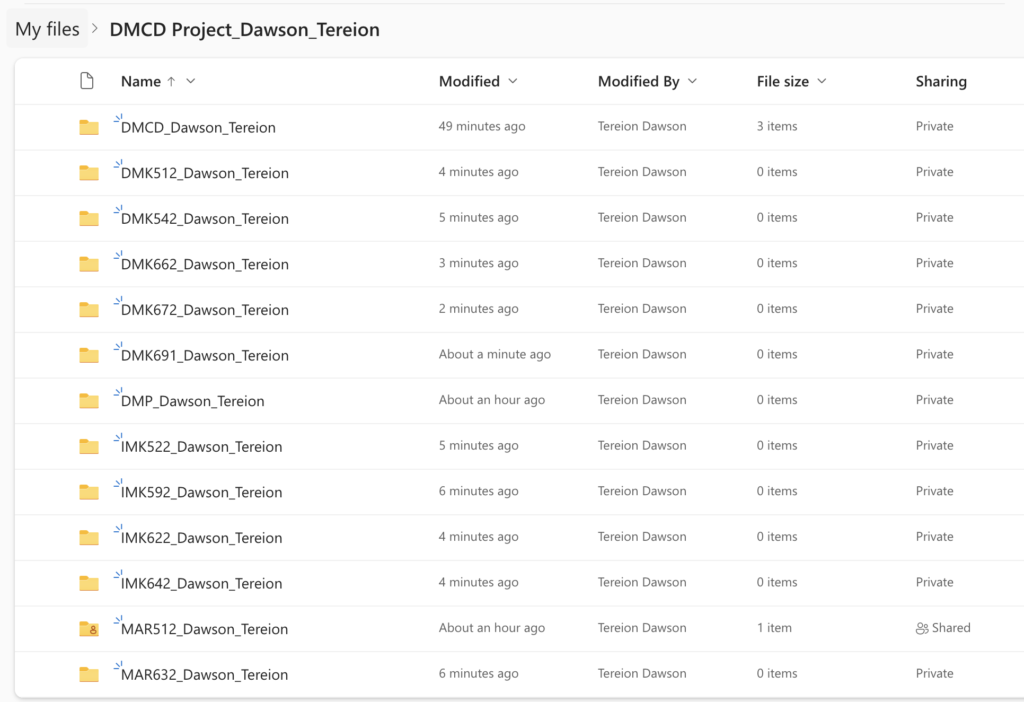Personal Reflection
Before entering my Digital Marketing Fundamentals course at Full Sail University, I honestly couldn’t wrap my mind around what I would learn. I honestly didn’t have much of an expectation and thought that information would be very generic; almost thought I would feel strung along. But I must admit, I was overwhelmed with how productive and secure this course has made me feel. All the information that I have been afforded in this course, I feel has allowed so much insight in what it is to be a professional digital marketer. I was a bit nervous to pursue my mastery degree, but my apprehensions have been may with reassurance from the course’s outlines, the way it is all set up for success and most importantly, the professors have all been amazingly informative and very helpful to date.
What I have learned in Digital Marketing Fundamentals is how to create a multi-media presentation on pay-per-click adverting. This project was two-fold for me: It allowed me to learn more about pay-per-click advertising and how to create a professional multi-media presentation for future projects. These skills are most defiantly transferable, and I plan to use these for my own company. Another skill that I have acquired in this course in how to create infographics, as well as, how to build a portfolio website to showcase my advisements towards being a digital marketing professional. These projects will all be compounded for a great foundation in my final project, which, will set me for success.
Course Outcomes
Develop a high-level digital marketing strategy that emphasizes search engine optimization, email marketing, social media marketing, and content marketing best practices.
Assignment: 4.3 Discussion/Website Analytics
Key Learnings: This discussion was very informative. I found it to be a pivotal point on my digital marketing journey. My takeaway in this lesson is the understanding of conversion, social media engagements, and customer satisfaction. I also learned that regarding email marketing one must consider open rate, clickthrough rate, conversions rate and unsubscribe rate.
Outcome:
A skill set of proficient website analysis with an emphasis on search engine optimalization, email marketing, social media marketing and content marketing. As a digital marketing professional, this assignment has laid a firm foundation of what is to be expected.
Explain key factors that affect how search engines crawl, index, and rank websites.
Assignment: Week 2: Search Engine Marketing
Key Learnings: There are many factors that affect how search engines crawl, index, and rank websites. Here are some of the key factors:
- Content relevance and quality: Search engines prioritize websites that have high-quality, relevant content that matches the user’s search query. Content should be original, well-written, and provide value to the user.
- Site structure and navigation: A website’s structure and navigation should be easy for search engine crawlers to follow, with a clear hierarchy and logical organization of pages.
- Mobile-friendliness and page speed: With the increasing use of mobile devices, search engines give preference to websites that are mobile-friendly and load quickly. This can be achieved through responsive design and optimization of images, code, and server response times.
- Backlinks and social signals: Backlinks from other reputable websites and social media mentions can help to improve a website’s authority and visibility in search results. However, it’s important to note that quality and relevance of the links are important, as low-quality or irrelevant links can have a negative effect.
- Technical optimization: Technical aspects such as metadata, sitemaps, robots.txt files, and schema markup can help search engines understand a website’s content and structure, making it easier to crawl and index.
- User experience: Search engines aim to deliver the best possible user experience, so factors such as bounce rate, time on site, and click-through rate can have an impact on a website’s rankings. A website that is easy to navigate, loads quickly, and provides a good user experience is more likely to rank well in search results.
It’s important to note that search engine algorithms are constantly evolving, so it’s important for website owners to stay up to date with best practices and make changes as needed to improve their website’s visibility and rankings.
Outcome:
A vast understanding of what search engine crawl, index and website ranking is.
Identify strengths and weaknesses of websites.
Assignment: 1.5 Research Paper
Key Learnings:
SWOT stands for:
– Strengths: internal factors that give the business an advantage over others
– Weaknesses: internal factors that put the business at a disadvantage compared to others
– Opportunities: external factors that could positively impact the business
– Threats: external factors that could negatively impact the business

The purpose of a SWOT analysis is to identify areas where a business can improve and areas where they have a competitive advantage. This helps the business make informed decisions about their strategies and goals. The analysis can be conducted on a regular basis to ensure that the business stays competitive and adapts to changes in the market.
PESTLE analysis is a strategic tool used to analyze the external macro-environmental factors that could affect an organization’s operations. The acronym PESTLE stands for Political, Economic, Sociological, Technological, Legal, and Environmental factors:
- Political factors: These refer to the government policies, regulations, and political stability that could affect an organization’s operations. For example, changes in tax policies, trade regulations, or government stability could impact a business.
- Economic factors: These include economic conditions such as inflation, interest rates, and economic growth that could affect an organization’s financial performance.
- Sociological factors: These refer to societal and cultural trends, attitudes, and behaviors that could affect an organization’s operations. For example, changes in demographics, lifestyle trends, or consumer preferences could impact a business.
- Technological factors: These include advancements in technology that could affect an organization’s operations. For example, innovations such as artificial intelligence, automation, or the rise of e-commerce could impact a business.
- Legal factors: These refer to laws and regulations that could affect an organization’s operations. For example, changes in employment laws, product safety regulations, or intellectual property laws could impact a business.
- Environmental factors: These include environmental issues such as climate change, sustainability, and resource depletion that could affect an organization’s operations. For example, an organization may need to adapt to new regulations or consumer preferences for eco-friendly products.
By analyzing these factors, organizations can identify potential opportunities and threats and adjust their strategies to adapt to changing external environments.
Outcome:

Conduct basic market analysis and industry research.
Assignment: 3.4 Competitor Website Analysis
Key Learnings: In this assignment, I learned I learned how to analysis a company’s potential competitor’s website. I also learned how to compare sites, clicks, top keywords and phrases. I also learned how about multi-browser compatibilities, along with page indexes.
Outcome:

Program Final Project Preparation

